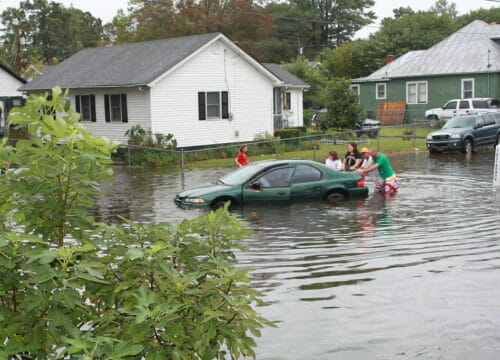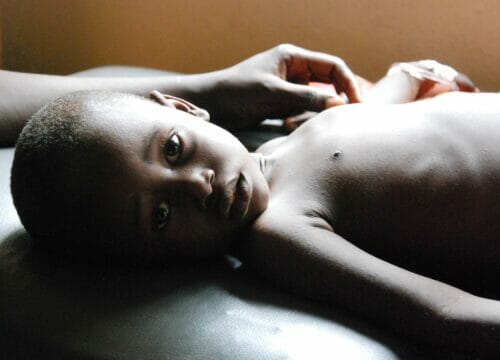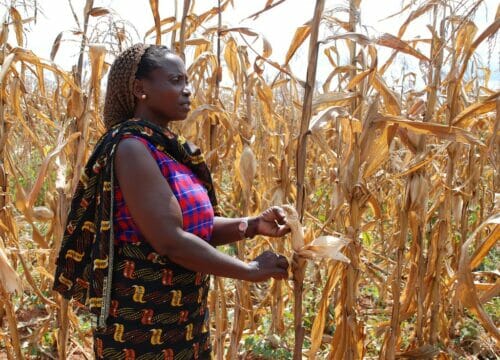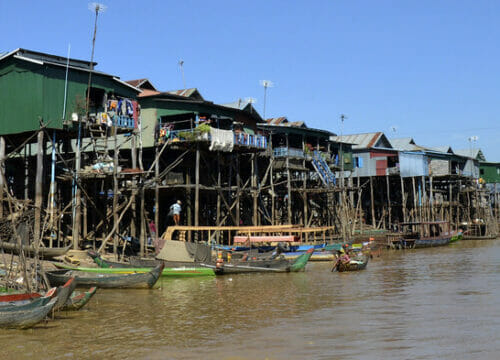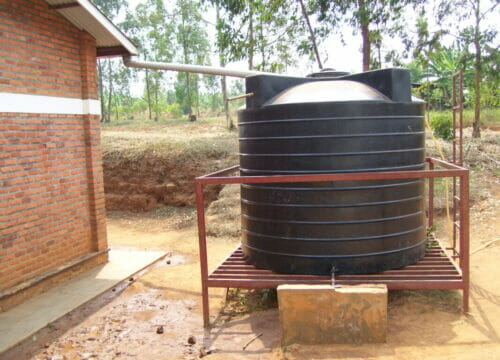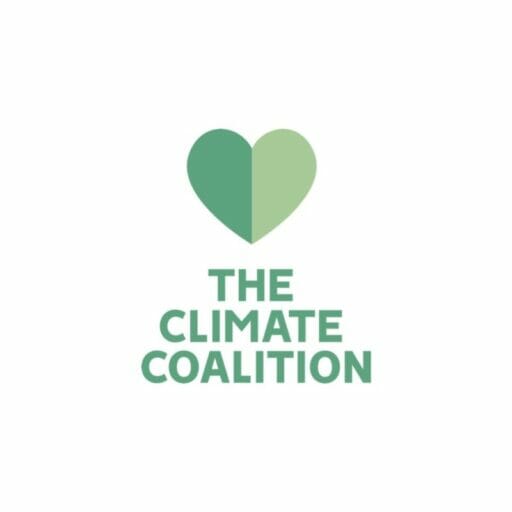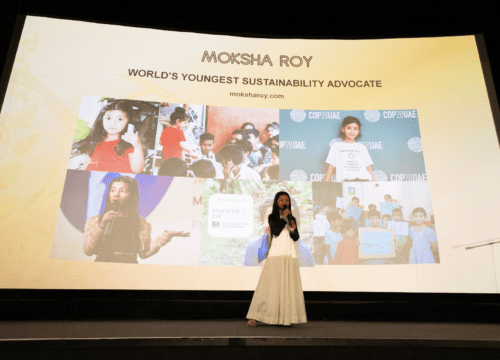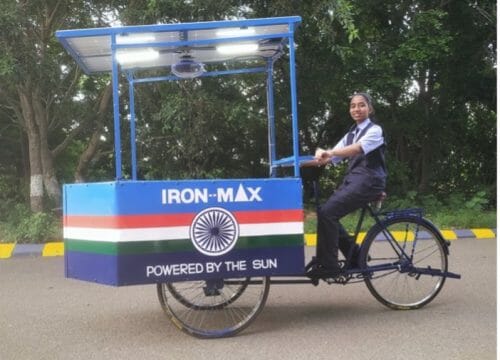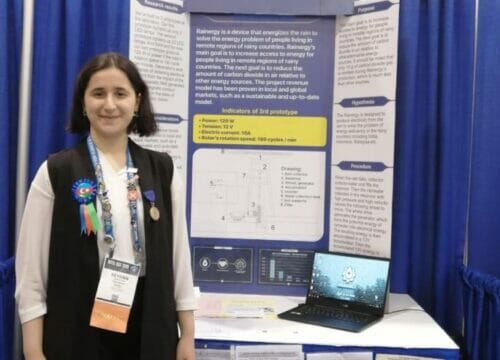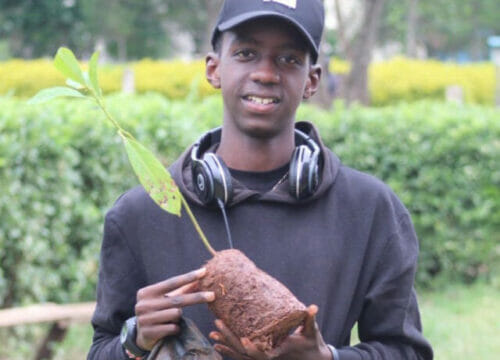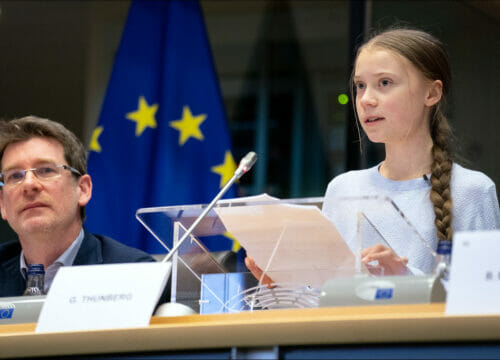Greenpeace is a movement of people who are passionate about defending nature. Our vision is a greener, healthier and more peaceful planet, that can sustain life for future generations.
Climate Action
Global warming and extreme weather

1. THE PROBLEM
Have you ever thought about how much the weather impacts life on earth?
Weather patterns affect everything, from the food that you eat, to how animals behave, to how the oceans stay healthy.
The problem is that human activity is causing weather patterns on Earth to change. Human activities, such as burning fossil fuels to create energy to power our homes, cars and factories, are releasing greenhouse gases into the atmosphere, which are trapping heat and causing the Earth to warm. This has knock on effects on weather patterns, like having more heatwaves, droughts, floods, fires and storms, impacting life on earth.

2. The Solution
So what can we do to help?
There are two parts to dealing with climate change. Firstly we need to learn to cope with climate change, for example by rebuilding homes to withstand storms or planting crops that can survive hotter climates. Secondly, we need to change the way we live and work so that there are no more greenhouse emissions. This involves changing the way we get around, use electricity or even the foods that we eat!

3. Take Action
There are lots of ways that anyone, including you, can make a difference to combat climate change. For example, you could: walk or cycle instead of driving or protest for climate with Fridays for Future.
Everyone can take action to make real change. What will you do?



4. CHARITIES
There are lots of charities that need your help to slow climate change.
For example, The Climate Coalition and Friends of the Earth campaign for people in power to make a change while Cool Earth works with rainforest communities to stop deforestation and its impact on climate change.
See how you can support them in their amazing work.
See how you can support them in their amazing work.
Have you ever snuggled up under a warm fluffy blanket on a winter’s night? The cosy warmth you get from a blanket happens, not because the blanket is warm, but because your body’s heat is trapped by the blanket, preventing it from leaving. That’s why it takes a little while to start feeling warm because the heat must build up under the blanket.
Greenhouses work in the same way. In a greenhouse, the sun’s light energy goes in through the glass, but the heat energy can’t leave through the glass again. This makes greenhouses nice and warm, helping plants grow in places that would otherwise be too cold.
Earth also has a type of ‘blanket’ around it – a layer of gases called greenhouse gases in the air. The greenhouse gases work like a greenhouse’s glass – the sunlight enters through them but can’t leave. Believe it or not, greenhouse gases are very important to Earth! They trap some of the Sun’s heat on the Earth’s surface and without them, Earth would be much too cold to allow anything to stay alive.
The greenhouse gases are in a delicate balance though. If the levels get too low, too much heat escapes out into space. If the levels get too high, they act like a super thick blanket, trapping too much heat on the Earth’s surface.
Greenhouse gases have been building up too much over the last two centuries and now the Earth is warming. This is called global warming, or climate change. Climate change will cause Earth’s weather patterns to change. This might not sound like a big deal, but weather patterns affect everything – from what you can eat, to how animals behave, to how the oceans stay healthy. Since everything on Earth is connected, a problem in one part of Earth’s natural systems has a domino effect on everything else.
Climate change is creating some massive problems and it is one of the biggest problems facing humanity right now. When you start feeling too hot under a blanket, you can simply kick it off. Unfortunately, we can’t just kick the layer of greenhouse gases off our planet.
The problem
1°C
WARMING SINCE THE INDUSTRIAL REVOLUTION
30%
more greenhouse gases are in the atmosphere since 1900
197
countries have signed the Paris Agreement
Since the industrial revolution, human activity has caused the Earth to warm by about 1°C. This doesn’t sound like so much, but keep in mind that it only takes an average drop of 6°C to plunge Earth into an ice age! So, a difference of a few degrees either up or down can change life as we know it here on Earth completely.
If human behaviour carries on with no changes, we are headed for an increase of between 3-5°C by 2100. Even if we do everything we can now, the warming can still only be limited to 1.5-2°C by the end of the century, which will have severe effects on some parts of the planet.
1. Why Has the Climate Changed?
For many years, there was a perfect natural balance of greenhouse gases in the atmosphere, keeping Earth at just the right temperature.
But, since the industrial revolution, human activities have been releasing more greenhouse gases into the atmosphere.
This is because, since this time, people have been digging up fossil fuels from the ground and burning them to make energy.
The problem is, when fossil fuels are burnt, they release greenhouse gases such as carbon dioxide and methane.
Greenhouse gases are also released when animals (like cows and pigs) fart or when rubbish decomposes in landfill.
Greenhouse gases are making Earth warmer and warmer all the time.
You might be wondering what the problem is – everyone likes sunny countries anyway, right?
2. Effects of Climate Change
Climate change increases the number of heatwaves, droughts, floods, fires, storms and air pollution.
The warming of the planet has effects that you wouldn’t expect, like some regions getting hotter for a while, ice caps melting and some regions getting more rain. All of these changing weather patterns are creating problems for humans, wildlife and the planet as a whole.
Take a look at a couple of the effects of climate change below.
Poor Health
The effects of climate change pose threats to the health of people on our planet.
For example,
- Soaring temperatures make people experience heat cramps, heat exhaustion and heatstroke.
- People may get injured during extreme events like floods and storms.
- More heat and rainfall means that mosquitoes (who like warm and wet places) can live in more places around the world so all the diseases they carry, like malaria, can spread further.
- Droughts make it trickier to get hold of clean water so people resort to using dirty water which may give them diarrhoeal diseases.
- Changing climate can lead to crop failure, causing famines which cause hunger and malnutrition.
- Seeing, and being affected by, these scary weather changes can cause people to become sad or anxious.
Food Becoming Scarce
Extreme weather events and changing climate make it hard for farmers to grow food.
- Storms, fires, floods, droughts, extreme heat, as well as unpredictable rainfall make it hard for crops to grow.
- Plants could get sick more easily when they are stressed by heat.
- When it is hot, it is very difficult to keep livestock like cattle and sheep well-fed.
All of this means that farmers could struggle to earn money and could become poorer. Some people could experience food shortages and hunger. When less food is available, it becomes more expensive.
Click here to read about the effects of the droughts in Ethiopia in 2015 (Africa) on farmer Hamid Heramo and his family.In the rainy season of 2015, 35-year-old Hamid Heramo planted crops to harvest. Hamid had been harvesting crops for many years and used to sell them to earn money to look after his family. This time, Hamid had noticed that each year there had been more and more droughts so he planted lots of different crops, in the hope that some would survive the dry weather. He planted pepper, maize, teff, sorghum, haricot beans and lots of other delicious things. After planting his crops, every morning Hamid would look up to the sky, hoping to see rain clouds. But day after day, there was no rain and the sun became stronger and stronger. As months went by without rain, Hamid’s crops began to die. Hamid started to get more and more worried. He felt a big responsibility to feed his children, but without his crops, it was simply impossible. Hamid started to feel anxious and depressed, so much so that he ended up having to go to hospital for treatment. Thankfully, with a bit of help, Hamid was able to learn about new agricultural methods to manage water and soil and was given some improved seeds that could withstand droughts. But sadly not everyone affected by droughts can receive the help that Hamid received.
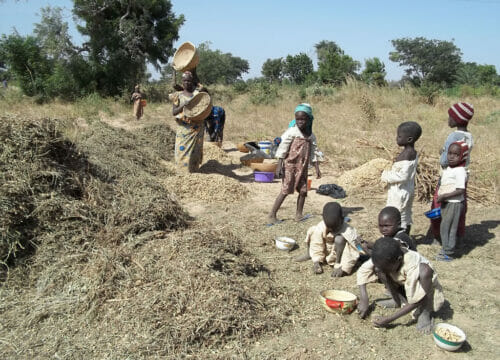
People Losing Their Homes and Livelihoods
Extreme weather events can have devastating effects on people’s homes and livelihoods.
For example:
- Rising temperatures cause sea ice to melt: This means there is more water in the ocean and sea levels start to rise so flat areas by the coast may go underwater and people will need to move. Click here to learn about the impacts of rising sea levels on Bangladesh.Bangladesh is a low-lying country in Asia. Because it is flat, even just a small rise in sea level captures a lot of land. This is a really big problem because 28% of the Bangladeshi people live on the coast. People are losing their homes, schools, hospitals and livelihoods. By 2050, one in every seven people in Bangladesh will be displaced.
- Rising temperatures cause wildfires: Wildfires can spread uncontrollably over large areas, affecting homes, businesses and farms. They also release smoke that can cause breathing problems in humans and animals. Click here to read about the wildfires in Australia in 2019 and 2020.In 2019 and 2020 Australia experienced terrible wildfires that burnt 180,000km2 of forest and the animals inside these forests. Families were forced to evacuate their hometowns and leave work, school and their belongings behind. And firefighters from all over the country were drawn in to help.
- Extreme rainfall causes floods: These floods can devastate people’s homes and livelihoods. When floodwater enters buildings, it can be very dangerous so people must evacuate immediately, leaving their belongings behind. Places that are near water and that are flat (without many mountains and hills) are most likely to flood. Flooding is one of the biggest climate change threats to the UK.
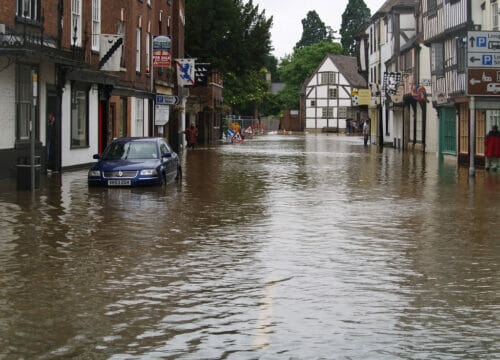
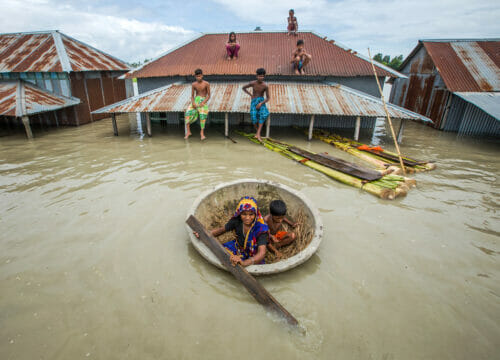
Unhealthy Ecosystems
Healthy ecosystems are needed for humans to be happy and healthy on Earth. Because of climate change, some species die out and then nature can’t do its job so well.
For example,
- Extreme heat is forcing some living things, like birds, plants and animals to move to cooler places because the place where they live is becoming too hot. The problem is that many species, especially plants, can’t move very far.
- Melting ice caps mean wildlife such as walruses and polar bears are losing their homes. The arctic ice (north pole) is expected to have completely ice-free summers by 2050 so the animals won’t be able to go anywhere.
About one out of every eight species could become extinct because of climate change.
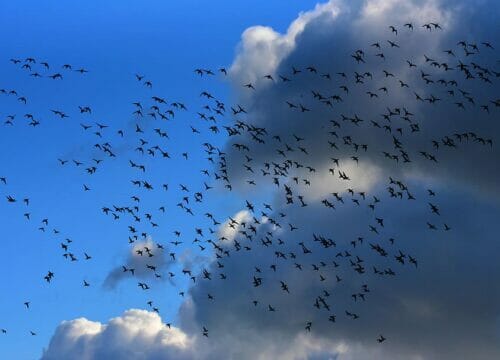
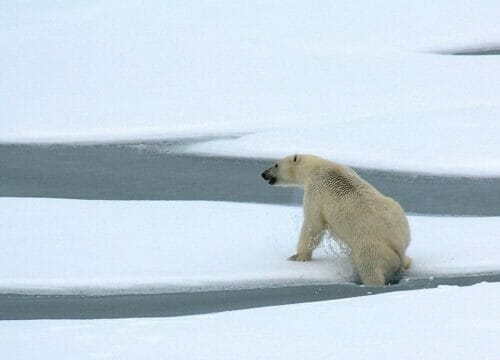
Struggling Economies
The effects of climate change are worse for people who are poor.
Poor people struggle more when food and water prices go up because of shortages.
Countries that are not well-off feel the effects of climate change more because they depend more on the food they grow. To make matters worse, most of these countries are in places that are hot already so they really can’t cope with getting a little bit hotter. Plus, these countries don’t have lots of money to spend on coping with problems that climate change creates.
Climate change could force 100 million people into poverty in the next 30 years.
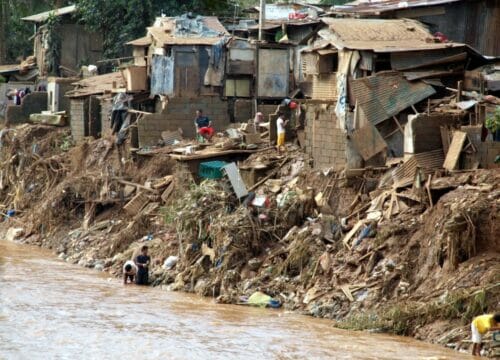
Take a Guess
The Solution
The solution for climate change consists of two parts.
Firstly, because global warming is already here and happening, something needs to be done to help everyone learn to cope with the problems it is creating.
Secondly, people, businesses and countries all over the world need to change the way that they live and work completely so that there are no more greenhouse gas emissions. This must be done as fast as possible because the longer the world takes to change, the worse climate change gets.
1. Coping With Climate Change
For example:
People can build their homes with:
- Stilts to elevate homes and protect them from floods.
- Shutters to protect windows from storms.
- Household rainwater harvesting systems to collect water when there is rain and save it for times of drought.
Farmers can:
- Plant a variety of crops so that even if one type is affected by extreme weather events, other types will survive.
- Use genetically modified crops that have been created to better withstand extreme weather events.
- Adopt irrigation methods that keep plants watered while wasting as little water as possible.


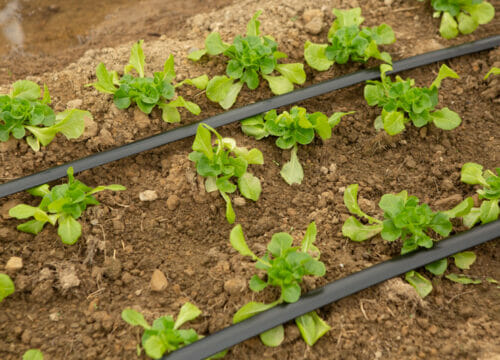
Countries and communities can:
- Prepare to welcome climate refugees. This includes making plans in advance on how to take care of them when they arrive and how to integrate them into society.
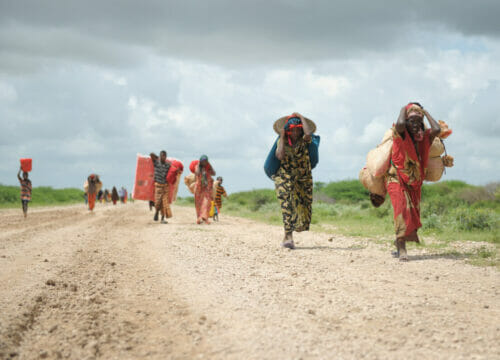
2. Get Everyone To Change Their Behaviour
For example, everyone can:
They can choose to walk, cycle or use public transport instead of driving. By using internet conferencing like Zoom, it is no longer necessary to travel all over the world to meet people.
Everyone needs to turn off lights and sockets when not in use, only use fans and heaters when needed and the list goes on!
Using renewable energies (such as wind and solar energy) instead of non-renewable energy (such as fossil fuels) is a much better choice.
Only buying the food that they need can help minimise waste.
They can eat locally produced foods and eat more vegetables and less meat.
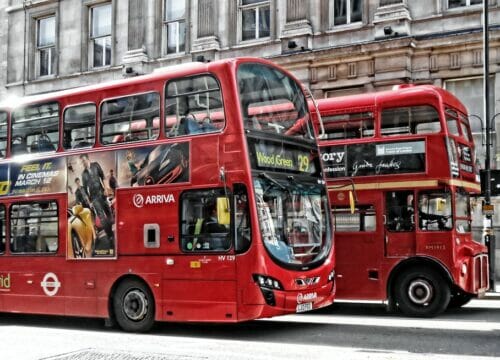
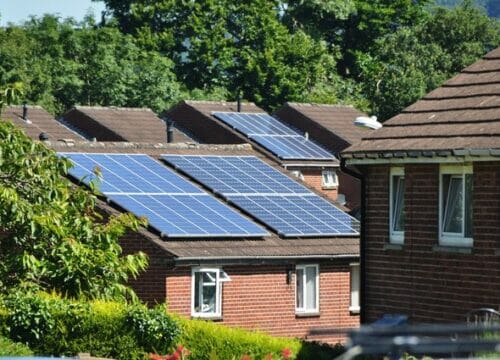
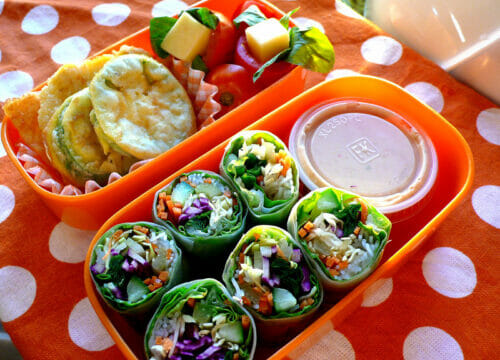
3. Why Has It Been So Hard to Tackle Climate Change?
Even though people have known about climate change for a very long time, it has been incredibly difficult to make change happen. Why has this been so hard?
There are two reasons:
Those who pollute the most don’t always feel the bad effects so much.
For example, a big factory in one country might be making bad choices about their energy source, but someone in another country might be experiencing a flood because of it. So, it has been hard to stop the big polluters from polluting when they are not experiencing serious consequences. Often, the countries that pollute the least, like the Maldives The Maldives are a group of low-lying islands that are responsible for less than 0.1% of the world’s carbon dioxide emissions. But the Maldives will probably go underwater in the next 60 years because climate change is making the sea levels rise. , are those that experience the most serious effects.
The effects of climate change are not severe enough yet.
This means people don’t yet feel the need to make uncomfortable changes, so many people are carrying on as normal.
4. How To Make These Changes Happen?
This is where governments and global cooperation can help.
International Cooperation on Climate Change – The Paris Agreement
When all countries unite and decide to work together against climate change, even countries who are not yet badly affected by climate change are encouraged to act.
In December 2015, countries all around the world came together and agreed to control their greenhouse gas emissions. This was called the Paris Agreement and has been signed by 197 countries.
They agreed to limit global warming to below 2°C above pre-industrial levels.
Each country set its own targets for climate action and agreed that these would be reviewed every five years.
5. Governments can make it easier for people and businesses to make these changes
For example:
Taxes and charges
Governments can use something called carbon tax. This is when products that make climate change worse are made to cost more. This encourages people to look for other, cheaper options that are better for the planet.
For example, some governments make fuel more expensive so that car drivers might then choose to drive more efficiently (for example by driving slower) or use another option (such as public transport or electric vehicles).
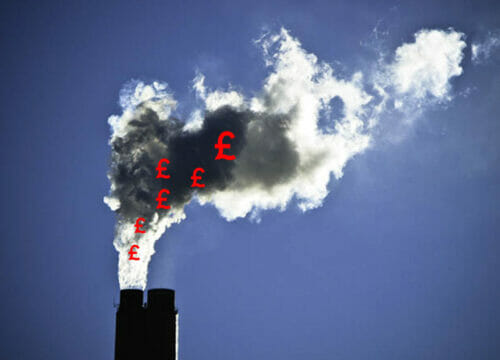
Subsidies and incentives
Governments can cover some of the cost of products that are good for the planet, making them more affordable.
For example, electric cars can be subsidised, meaning that the government pays for some of the car, making it less expensive for the buyer.
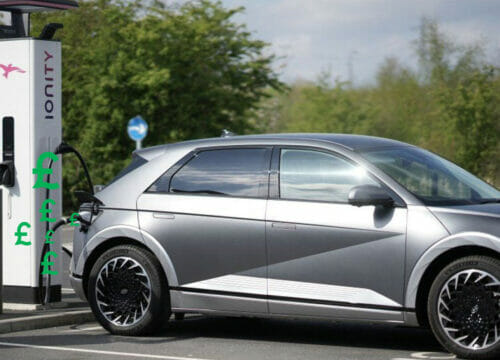
Education
Governments can educate people on what is good and bad for the environment, so that they can make the right decisions.
For example, people might choose to get the train instead of an aeroplane if they knew more about the consequences of air travel.
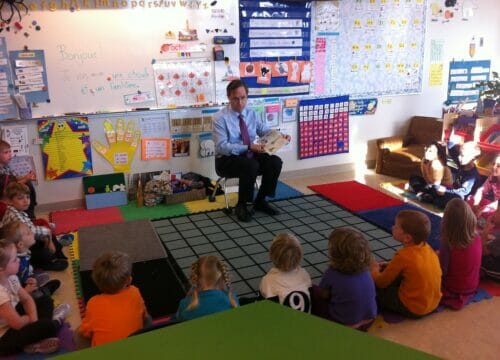
Making companies publish reports on how environmentally friendly they are
Governments can force companies to tell everyone about the things they do and how good it is for the health of the planet. They want to look good to their customers, so when the things they do are public knowledge, they’ll think twice about doing something that makes climate change worse.
For example, a buyer might choose to buy paper cups from a company that uses recycled paper rather than a company that contributed directly to deforestation to make their paper cups.
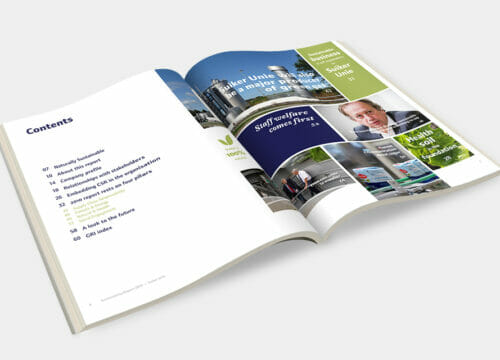
Take action
Now that you understand a bit more about climate change, it’s time to make a difference. Climate change can feel very scary because it affects everyone and there are too many problems for one person to solve. Just remember that humans can decide now how bad climate change will become. Any positive change you make will be slowing climate change down – even if that only means you’re putting a kilogram less of carbon dioxide into the air. If everyone on Earth puts a kilogram less in the air, that’s 7 million tonnes less! So even small changes add up quickly. If you want to do something practical to help, the power is in your hands. Take a look at some ways you can take action right now.
Fundraise
- You can make a massive difference to people and the planet by doing fundraising for charities that work to fight climate change. Some of the things the money you raise can achieve:
- £1 plants a tree to absorb carbon dioxide.
- £50 pays to offset one ton of carbon dioxide.
- £6,000 pays for enough solar panels to power a home.

- Click here to use the World Wildlife Fund’s Carbon Footprint calculator. As you answer the questions, think about the carbon footprint of all of the things you do and whether you could change any of your actions.
- Walk or cycle when possible. If you need to use a vehicle to get around, try to use public transport. If you need to use a personal car, go electric!
- Switch off lights, unplug any chargers and devices when not in use, hang up your clothes to dry rather than using the dryer and avoid using air conditioning or heating until you need to.
- Waste as little food as possible by only buying what you need and think of creative ways to use up your old fruit and vegetables. Click to find some recipes of ways you can use up your old fruit and vegetables in smoothies, banana breads or vegetable soups.
- Eat fruit and vegetables that are in season in your country, so they do not have to be flown in from abroad on a plane that guzzles fossil fuels and emits greenhouse gases!
- Follow a planet-friendly diet. This includes eating less meat and more vegetables since animal agriculture emits more carbon dioxide than vegetables.
- Write to your MP to ask them to order that more trees be planted in your local council.
- Write to your headteacher to ask them to encourage walking and cycling to school. If your school doesn’t currently use the WOW Walk to School reward system, you could introduce your headteacher to it and ask for them to start it at your school. You can read about it here.
- Write to businesses to ask them to limit the amount of travel they use for business. Remind them that we are lucky to have video conferencing available to us which limits the need to travel around the world to meet people.
- Write to businesses to ask them to make it attractive for their employees to travel to work in planet-friendly ways. For example, they could offer a cycle-to-work scheme or provide discounts on public transport. Of course, it is even better if they allow people to work from home sometimes!
- Write to businesses to recommend that they plant trees to offset their emissions. Tell them about the National Trust tree planting scheme, where people and businesses can donate money to have the National Trust plant trees on their behalf. Check out the tree planting scheme here.
- Write to the cafes and restaurants that you know and ask them to donate surplus food to charity so that it can be used rather than going to landfill. You could tell them about The Trussell Trust or TooGoodToGo and recommend that they contact them.
- Write to the cafes and restaurants that you know to ask them to start buying their ingredients locally. For example, you could ask a restaurant to offer apple crumble in autumn and rhubarb crumble in summer, since apples grow in winter in the UK and rhubarb grows in winter.
- Write to businesses to ask them to set targets to reduce their carbon emissions and strive to meet their targets. When they absolutely have to use carbon dioxide-emitting processes, they could offset the carbon dioxide produced by planting trees.
- Make a poster to teach people about the changes that they can make to help reduce climate change. For example, people can: turn lights off when not in use, avoid using air conditioning or heating unless they need to, cycle or walk, when possible, minimise food waste and the list goes on!
- Encourage your friends and family to consider their carbon footprint and help them come up with ideas for how to reduce it. You could suggest they start by taking the World Wildlife Fund’s Carbon Footprint calculator.
- Talk to your friends and family and encourage them to switch to a green energy supplier.
- Encourage your friends and family to plant trees to absorb carbon dioxide. If you cannot plant a tree yourself there are lots of charities that you can plant trees with. Simply donate some money (approximately £5 for a tree) and they will plant a tree for you! Check out the National Trust tree planting scheme here.
- Start a gardening club at your school. Together you could grow fruit and vegetables to serve in the canteen or plant flowers and shrubs to absorb carbon dioxide.
- Start a cooking club at your school. Use the cooking club to help promote delicious and planet-friendly meals made using locally sourced, in-season produce. Specifically, you could try and make your cooking club meat-free.
- Protest for climate. Check out the Fridays for Future website or the UK Student Climate Network (if you are in the UK) to find a protest near you. If you can’t find a protest near you then create your own! Don’t forget to get permission from your parent or guardian to miss school and make sure that a responsible adult joins the protest with you.

If you have any other ideas of SuperKind things people can do to stop climate change, we would love to hear from you here.
Support These Amazing Charities
The Climate Coalition
Over 100 organisations. 22 million strong. We are the UK’s largest group of people dedicated to action against climate change.
Children’s Book Project
The Children’s Book Project is a charity that aims to make sure every child has their very own books to read and enjoy. 📚✨
SolarAid
Our mission is to light up every home, school and clinic in Africa by 2030, using safe, clean, solar power. Together, we are making light work.
Renewable World
We envision a world where renewable energy is readily accessible to all, helping to end extreme poverty and mitigate climate change.
Cool Earth
Cool Earth works with rainforest communities to stop deforestation and its impact on climate change.
Clean Air Task Force
CATF is on a mission to push the change in technologies and policies needed to get to a zero-emissions, high-energy planet at an affordable cost.
Campaign for Better Transport
Campaign for Better Transport is the leading national charity making the case for public transport’s vital role in protecting the environment, connecting communities and supporting the economy.
Change-Makers
Here are some amazing young people who cared about climate change and took action to make change happen. These change makers were all passionate about the same cause but used their unique skills to make change happen in different ways.
Everyone can help make a difference. Consider what your unique superpower might be. Are you someone with a strong voice who likes to spread awareness by talking to everyone you meet? Or do you prefer a behind the scenes approach – making sure that donations are collected to take to those in need?
Moksha Roy
The world’s youngest sustainability advocate – working to make the world a better place since she was 3 years old.
Vinisha Umashankar
Designing a solar powered ironing cart to reduce charcoal burning in India since she was 12 years old.
